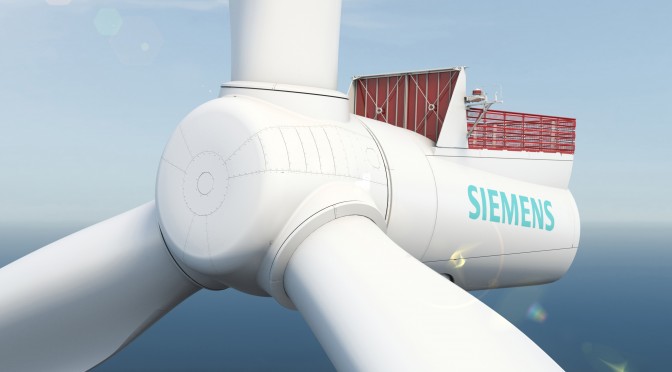Siemens Taiwan President and CEO Erdal Elver vowed Wednesday to establish Taiwan as a regional offshore wind power hub.
At a press event, the company reiterated its mission to use its technologies in offshore wind power, gas-fired power generation and energy efficiency via digitalization to help establish a sustainable energy future for Taiwan.
President Tsai Ing-wen recently announced the latest energy mix plan for Taiwan in 2015 — 20 percent renewable, 50 percent natural gas and 30 percent coal-fired power. Siemens Taiwan President and CEO Erdal Elver, Deputy Director General of German Institute Taipei Sabrina Schmidt-Koschella and Taiwan Institute for Sustainable Energy Dr. Eugene Chien all welcome the ambitious plan.
They agree that transforming the energy sector in Taiwan will not only help fulfill Taiwan’s responsibility in reducing its greenhouse gas emissions, but also help establish a sustainable future for Taiwan. The three leaders jointly stressed on the importance of bringing policies, societies and technologies together as a comprehensive approach will win the battle against global warming and to realize Taiwan’s energy transformation.
From the technology perspective, Elver has specified three key levers for Taiwan’s sustainable energy future: offshore wind energy, gas-fired power generation and energy efficiency in buildings, energy grids and mobility through Digitalization. Siemens is committed in bringing in proven technologies and total solutions to Taiwan. Taking the development of offshore wind power as an example, Siemens will provide products suited for the climatic conditions in Taiwan and the rest of APAC. Siemens will also establish in Taiwan the hub for offshore wind power activities in the APAC region.
As pointed out by Erdal Elver, “Speeding up and scaling up offshore wind power development in Taiwan is certainly important; but accelerating the development and deployment of gas-fired power generation and enhancing the energy efficiency in buildings, grids and mobility are equally important. In the foreseeable future, fossil power generation will remain as a stable base load of electricity supply.
Within the fossil power sector, gas-fired power generation is cleaner than its coal-fired counterpart and can serve as the backbone of a reliable energy supply. And technologies for increasing energy efficiency are already available today. They only need to be deployed! Digitalization will further boost the implementation of energy efficiency measures in buildings, mobility and grid management.”
The 22nd session of the Conference of the Parties (COP22) of the U.N. Framework Convention to Climate Change focused on the implementation of Paris Agreement. Societies, industries and countries are now taking actions to battle against global warming. Meanwhile, the Taiwanese government has announced ambitious plans to restructure the island’s energy mix. Siemens’ technologies have proven to achieve energy efficiency and carbon reduction across the entire energy chain, including energy generation, transmission and distribution, and consumption. Specifically, the company’s technologies in offshore wind power, gas-fired power generation and energy efficiency via digitalization can help realize Taiwan’s energy transformation and establish a sustainable energy future for the island.
With the Environmental Portfolio, Siemens has helped customers worldwide to reduce CO2 emission by over 500 million tons last year, which is equivalent to almost 60 percent of the annual CO2 emission of Germany. With its own CO2 Neutral program, Siemens has already cut its own CO2 emission by 20 percent in fiscal year 2016. Siemens technologies have achieved carbon reduction as well as energy efficiency in areas like power plants, manufacturing facilities, buildings, grids and mobility.
In the 2016 fiscal year, Siemens Taiwan has achieved remarkable milestones in alignment with Taiwanese government’s innovative industries policies. For Smart Machinery, Siemens signed a MoU with Taichung City Government and HIWIN Technologies respectively. For Sustainable Energy, the first two offshore wind turbines were erected along the coastal areas in Miaoli. Siemens also helped to upgrade the existing power plants such as NANPU Combined Cycle Power Plants to reduce carbon emission.
For Intelligent Infrastructure, TAIPEI 101 applied Siemens cloud-based building energy and sustainability management platform Navigator to make the skyscraper more intelligent and even greener. Taiwan Power Company will implement Siemens Area Dispatch Control Center software for power transmission, distribution and grid-control systems and pave the way of digitalization, especially for the add-on module of smart-grid application, load balancing of the power grids, etc.
Upholding its commitment to “Grow Taiwan Together,” in 2017, Siemens Taiwan will continue to work with partners such as ITRI to complete the first Smart Machinery demo site in Taiwan/Taichung City, and with international and Taiwanese stakeholders on offshore wind power projects and on local industry value chain development.
Siemens also vowed to bring in solutions and technologies to support Taiwan’s energy mix plan of 50 percent in gas-fired power generation in order to contribute to a sustainable energy future of Taiwan.


